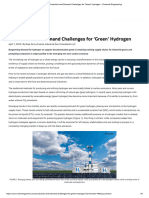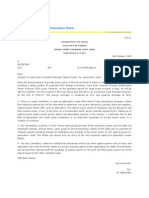Plant Simulation Manufacturing
Plant Simulation Manufacturing
Uploaded by
Carlos MolinaCopyright:
Available Formats
Plant Simulation Manufacturing
Plant Simulation Manufacturing
Uploaded by
Carlos MolinaCopyright
Available Formats
Share this document
Did you find this document useful?
Is this content inappropriate?
Copyright:
Available Formats
Plant Simulation Manufacturing
Plant Simulation Manufacturing
Uploaded by
Carlos MolinaCopyright:
Available Formats
Tecnomatix
Plant Simulation
Plant, line and process simulation and optimization
fact sheet
Siemens PLM Software www.siemens.com/plm
Summary
Tecnomatix Plant Simulation software enables the simulation and optimization of production systems and processes. Using Plant
®
Simulation, you can optimize material flow, resource utilization and logistics for all levels of plant planning from global production
facilities, through local plants, to specific lines.
Benefits In times of increasing cost
Enhance productivity of existing and time pressures in
production facilities by as much as production, along with
15-20 percent
ongoing globalization,
Reduce investment in planning
new production facilities up to logistics has become a key
20 percent factor in the success of a
Cut inventory and throughput time company. The need to
by 20-60 percent deliver JIT (just-in-time)/ JIS
Optimize system dimensions, (just-in-sequence), introduce
including buffer sizes Kanban, plan and build new
Reduce investment risks by early production lines and manage
proof of concept
global production networks
Maximize use of manufacturing
resources (to name a few) require objective decision criteria to help management evaluate and compare
Improve line design and schedule alternative approaches.
Plant Simulation helps create digital models of logistic systems (e.g., production) to explore the
systems’ characteristics and to optimize its performance. The digital model enables users to run
experiments and what-if scenarios without disturbing an existing production system or – when used
in the planning process – long before the real system is installed. Extensive analysis tools, statistics
and charts let users evaluate different manufacturing scenarios and make fast, reliable decisions in the
early stages of production planning.
Plant Simulation helps users:
• Detect and eliminate problems that otherwise would require cost- and time-consuming correction
measures during production ramp-up
• Minimize the investment cost of production lines without jeopardizing required output
• Optimize the performance of existing production systems by taking measures that have been
verified in a simulation environment prior to implementation
fact sheet Tecnomatix
Features Modeling manufacturing processes using libraries of standard and specialized
Simulation of complex production components
systems and control strategies Plant Simulation enables you to create well-structured, hierarchical models of production facilities,
Object-oriented, hierarchical lines and processes. This is achieved through powerful object-oriented architecture and modeling
models of plants, encompassing
business, logistic and production capabilities that enable you to create and maintain even highly complex systems, including advanced
processes control mechanisms.
Dedicated application object
libraries for fast and efficient
Plant Simulation’s user interface follows Microsoft Windows standards, making it easy to get familiar
modeling of typical scenarios and productive quickly. Simulation models can be created quickly by using components from application
Graphs and charts for analysis of object libraries dedicated to specific business processes, such as assembly or carbody manufacturing
throughput, resources and processes. Users can choose from predefined resources, order lists, operation plans and control rules.
bottlenecks By extending the library with your own objects you can capture best-practice engineering experiences
Comprehensive analysis tools, for further simulation studies.
including Automatic Bottleneck
Analyzer, Sankey diagrams and Complex and detailed simulations can be handled, understood and maintained much better than in
Gantt charts
conventional simulation tools by using Plant Simulation architectural advantages like capsulation,
3D online visualization and animation
inheritance and hierarchy.
Integrated neural networks and
experiment handling
Simulating system performance
Genetic algorithms for automated
optimization of system parameters Plant Simulation simulations are used to
Open system architecture optimize throughput, relieve bottlenecks
supporting multiple interfaces and and minimize work-in-process. The
integration capacities (ActiveX, simulation models take into consideration
CAD, Oracle SQL, ODBC, XML,
Socket, etc.) internal and external supply chains,
production resources and business
processes, allowing you to analyze the
impact of different production variations.
You can evaluate different line production
control strategies and verify
synchronization of lines and sub-lines. The
system lets you define various material flow
rules and check their effect on the line’s
performance. Control rules are chosen
from libraries and may be further detailed to model highly sophisticated controls.
The Plant Simulation experiment manager allows you to define multiple experiments at one time,
providing an efficient way to analyze and optimize your system. Based on user-defined parameters, Plant
Simulation executes different simulation runs and provides you with the results of these experiments.
fact sheet Tecnomatix
Automatic optimization
Optimization can also be done automat-
ically by using the Plant Simulation genetic
algorithms module. This is especially
useful if a variety of system parameters
and constraints make it difficult to find
the optimum.
Genetic algorithms optimize system
parameters while considering multiple
constraints such as throughput, inventory,
utilization of resources and delivery dates.
These solutions are further evaluated by using simulations to interactively find the optimal solution
according to line balance and various lot sizes.
Analyzing simulation results
Plant Simulation analysis tools allow for
easy interpretation of simulation results.
Statistical analysis, graphs and charts display
the utilization of buffers, machines and
personnel. You can generate extensive
statistics and charts to support dynamic
analysis of performance parameters
including line workload, breakdowns, idle
and repair time and proprietary key
performance factors.
At the click of a button, Plant Simulation’s
bottleneck analyzer shows the utilization of resources, thus indicating bottlenecks as well as
underworked machines.
Material flow may be visualized in a Sankey chart that, at a glance, shows transport volume in the
context of the layout.
Plant Simulation also generates a Gantt chart of the optimized production plans that can be
modified interactively.
3D visualization
In addition to the highly efficient 2D view, simulation may be visualized in a virtual, reality-like 3D
environment. Using Plant Simulation’s libraries or CAD data, impressive 3D models can be built and
used in several ways, including:
• Easy-to-understand platform for internal and external discussions
• Management presentations
• Demonstration to customers
• Trade show displays
• Brochures, animations and other sales tools
UK Reseller Contact
Simulation Solutions Limited Siemens PLM Software
Unit 10, Rugby Park, Americas 800 498 5351
Bletchley Road, Europe 44 (0) 1276 702000
Heaton Mersey, Asia-Pacific 852 2230 3333
Stockport SK4 3EJ, UK www.siemens.com/plm
Tel: (+44) (0)161 947 9113, © 2008 Siemens Product Lifecycle Management Software Inc. All rights reserved. Siemens and the Siemens logo are registered trademarks of Siemens AG.
Fax: (+44) (0)161 947 9099 Teamcenter, NX, Solid Edge,Tecnomatix, Parasolid, Femap, I-deas, JT, UGS Velocity Series and Geolus are trademarks or registered trademarks of Siemens Product
Lifecycle Management Software Inc. or its subsidiaries in the United States and in other countries. All other logos, trademarks, registered trademarks or service
Web: www.simsol.co.uk marks used herein are the property of their respective holders. 1/08
You might also like
- Simplified Qabala Magic by TedDocument190 pagesSimplified Qabala Magic by TedYaprak A100% (11)
- Information Security AwaremessDocument7 pagesInformation Security Awaremesspavan kumar50% (4)
- PS Worksheet 1 - NucleosynthesisDocument2 pagesPS Worksheet 1 - NucleosynthesisYoshiro Yang100% (1)
- West Bengal DisaporaDocument301 pagesWest Bengal Disaporaaman.4uNo ratings yet
- ArcGIS 10 Intro Exercise PDFDocument10 pagesArcGIS 10 Intro Exercise PDFDamai WongNo ratings yet
- BIM Model Management PDFDocument6 pagesBIM Model Management PDFpyaephyozawNo ratings yet
- Fume Extractor SMOVEX Series 1Document4 pagesFume Extractor SMOVEX Series 1Anonymous eq5zSUNo ratings yet
- Engineering Drawing (With (3) CD-ROM) - Plane and Solid Geometry - FlipkartDocument3 pagesEngineering Drawing (With (3) CD-ROM) - Plane and Solid Geometry - Flipkartrvejner52530% (1)
- Fume Extraction SystemDocument1 pageFume Extraction SystemPathak EnterprisesNo ratings yet
- Report Captive Power in India June 2013Document4 pagesReport Captive Power in India June 2013Sudhansu Kumar NaikNo ratings yet
- Practice 01 3.1document1Document11 pagesPractice 01 3.1document1Rob WillestoneNo ratings yet
- Contract CostingDocument6 pagesContract CostingAakash HaritNo ratings yet
- 3 D Modelling and Finite Element Analysis of Eot CraneDocument4 pages3 D Modelling and Finite Element Analysis of Eot CraneKenneth ShumNo ratings yet
- Current Project PDFDocument108 pagesCurrent Project PDFgo25101992No ratings yet
- Bulk Water SeparationDocument1 pageBulk Water SeparationSean MiddletonNo ratings yet
- QB400Document2 pagesQB400Éverton KafskiNo ratings yet
- Green Hydrogen Prod & Demand ChallengesDocument5 pagesGreen Hydrogen Prod & Demand ChallengesM SidinaNo ratings yet
- PTPL Tubing & Products Private LimitedDocument3 pagesPTPL Tubing & Products Private LimitedANIMESH JAINNo ratings yet
- C++ Lab ManualDocument26 pagesC++ Lab ManualVidya Sagar S DanappanavarNo ratings yet
- Lecture 4 - ISA Standards and Line SymbolsDocument23 pagesLecture 4 - ISA Standards and Line SymbolsAbdul RehmanNo ratings yet
- West Bengal Schedule Rates of Sanitary Plumbing Works 2015Document125 pagesWest Bengal Schedule Rates of Sanitary Plumbing Works 2015parthiv100% (2)
- Bhilai Captive Power PlantDocument3 pagesBhilai Captive Power PlantSha HaabNo ratings yet
- Industrial Report On Production Process of Steel Mills LTD: A Study On Ratanpur Steel Re-Rolling MillsDocument21 pagesIndustrial Report On Production Process of Steel Mills LTD: A Study On Ratanpur Steel Re-Rolling MillsAbid HasanNo ratings yet
- Bhilai Steel Plant BhilaiDocument7 pagesBhilai Steel Plant BhilaiRahul PandeyNo ratings yet
- Pulley Assembly 2015Document1 pagePulley Assembly 2015Fitra VertikalNo ratings yet
- Captive Power Plant - A Case Study of Cetp Ichalkaranji, MaharashtraDocument6 pagesCaptive Power Plant - A Case Study of Cetp Ichalkaranji, MaharashtraesatjournalsNo ratings yet
- Aspen Plus Simulation and Optimization of IndustriDocument8 pagesAspen Plus Simulation and Optimization of IndustriAbderrahman MahiddiniNo ratings yet
- Natural Gas Dehydratation Process SimulationDocument5 pagesNatural Gas Dehydratation Process SimulationAndrea Tellan100% (1)
- Shelf of ProjectsDocument192 pagesShelf of ProjectsTirthankar BasuNo ratings yet
- BIM - Building Information ModellingDocument20 pagesBIM - Building Information ModellingSyeda SumayyaNo ratings yet
- 2business Center-Section-2 Sanitary & Plumbing PPDocument43 pages2business Center-Section-2 Sanitary & Plumbing PPSourov SamadderNo ratings yet
- Application of Process Simulation Software METSIMDocument7 pagesApplication of Process Simulation Software METSIMBart FrienderNo ratings yet
- CP Lab ManualDocument101 pagesCP Lab ManualashishNo ratings yet
- Class Xi CPP NotesDocument27 pagesClass Xi CPP NotesVibhor KaushikNo ratings yet
- Rolling Element Bearing Analysis PDFDocument8 pagesRolling Element Bearing Analysis PDFLong NguyenNo ratings yet
- Components Design of Hoisting Mechanism of 5 Tonne Eot CraneDocument6 pagesComponents Design of Hoisting Mechanism of 5 Tonne Eot CraneRahman Listanto100% (1)
- Strategy Analysis and Proposal Development: ExpedientDocument7 pagesStrategy Analysis and Proposal Development: ExpedientNazneen Islam JabeenNo ratings yet
- Final Project - Analyze and Design A Multi-Storied BuildingDocument40 pagesFinal Project - Analyze and Design A Multi-Storied Buildingyash vermaNo ratings yet
- STAAD - Bending Moment in Plate Elements - Structural Analysis and Design - Forum - Structural Analysis and Design - Bentley CommunitiesDocument9 pagesSTAAD - Bending Moment in Plate Elements - Structural Analysis and Design - Forum - Structural Analysis and Design - Bentley Communitiessom_bs79No ratings yet
- Automation of Captive Power Plant Using PLC and DcsDocument3 pagesAutomation of Captive Power Plant Using PLC and DcsAnju JacobNo ratings yet
- S/N Description Unit A Steel Structure Definitions: Prepared by 1305 Engineering and Construction LTDDocument18 pagesS/N Description Unit A Steel Structure Definitions: Prepared by 1305 Engineering and Construction LTDCobbinah Mark0% (1)
- Thermax LTD - 1500 TR - 0 Bar and 0.4 Bar - R0 - 23.04.19 PDFDocument26 pagesThermax LTD - 1500 TR - 0 Bar and 0.4 Bar - R0 - 23.04.19 PDFAmit S RanaNo ratings yet
- West Bengal ReportDocument12 pagesWest Bengal Reportrajkumaraj23100% (2)
- Policy For CaptiveDocument17 pagesPolicy For CaptiveRamesh AnanthanarayananNo ratings yet
- 4.furnaces: What Is A Furnace?Document36 pages4.furnaces: What Is A Furnace?aravind grandhiNo ratings yet
- Bokaro Steel PlantDocument3 pagesBokaro Steel PlantSayan ChatterjeeNo ratings yet
- Process Plant DesignDocument28 pagesProcess Plant DesignAnik AichNo ratings yet
- Aspen Plus Simulation of Polyethylene GasificationDocument17 pagesAspen Plus Simulation of Polyethylene Gasificationkishna009No ratings yet
- EOT Format ALTDocument6 pagesEOT Format ALTBala Krishna GallaNo ratings yet
- Structural EngineeringDocument18 pagesStructural EngineeringLeslie MercadoNo ratings yet
- Rolling of Steel Plates in A Plate Rolling MillDocument20 pagesRolling of Steel Plates in A Plate Rolling MillKASHIFNo ratings yet
- Main - Product - Report-Tangshan Shengcai Steel Co., Ltd.Document10 pagesMain - Product - Report-Tangshan Shengcai Steel Co., Ltd.hbookNo ratings yet
- Chapter-6 Fans and BlowersDocument62 pagesChapter-6 Fans and Blowersye htutkyawme100% (1)
- CBSE Class XI Computer Science NotesDocument31 pagesCBSE Class XI Computer Science Notesexpertarjun63% (19)
- Calculation Sheet of RCC Frame BuildingDocument77 pagesCalculation Sheet of RCC Frame BuildingShubham PuriNo ratings yet
- 2.4 Furnaces PDFDocument29 pages2.4 Furnaces PDFOmarNo ratings yet
- Cost Comparison 5-5-18Document76 pagesCost Comparison 5-5-18Charlote EspinosaNo ratings yet
- Plant Simulation Siemens SW Tecnomatix Foundation FS 81678 C8Document2 pagesPlant Simulation Siemens SW Tecnomatix Foundation FS 81678 C8jOSELYN MNo ratings yet
- Plant Simulation: Simulation and Optimization of Production Systems and ProcessesDocument2 pagesPlant Simulation: Simulation and Optimization of Production Systems and ProcessesMateo QuispeNo ratings yet
- Plant Simulation Fact Sheet Book HQ-ilovepdf-compressed PDFDocument87 pagesPlant Simulation Fact Sheet Book HQ-ilovepdf-compressed PDFМануэль МендосаNo ratings yet
- Siemens Plant Simulation PDFDocument87 pagesSiemens Plant Simulation PDFMarko Matić100% (1)
- Tecnomatix Plant Simulation PDFDocument2 pagesTecnomatix Plant Simulation PDFynottripNo ratings yet
- Siemens Tecnomatix Plant Simulation Assembly 9729 - tcm1023 4961Document3 pagesSiemens Tecnomatix Plant Simulation Assembly 9729 - tcm1023 4961Florea AdrianNo ratings yet
- Jaiprakash Power Ventures LTDDocument8 pagesJaiprakash Power Ventures LTDMilind DhandeNo ratings yet
- Maxsurf 7: Manual de UsuarioDocument144 pagesMaxsurf 7: Manual de Usuariosiriovagabundo100% (1)
- All India Network Hospitals GeneralDocument480 pagesAll India Network Hospitals GeneralAkshay KuriNo ratings yet
- Mini Project II ReportDocument22 pagesMini Project II ReportMenma100% (1)
- Agroecology-Based Local Communities' Vulnerability To Climate Change in Tembaro District, Southern EthiopiaDocument16 pagesAgroecology-Based Local Communities' Vulnerability To Climate Change in Tembaro District, Southern EthiopiaSocial Science Journal for Advanced ResearchNo ratings yet
- Win in Thinking SkillsDocument77 pagesWin in Thinking SkillsBai Li100% (1)
- Review Article TAG-New Generation of Implants DesignDocument5 pagesReview Article TAG-New Generation of Implants Designdrzana78No ratings yet
- Grade 4 DLL Quarter 4 Week 4 (Sir Bien Cruz) - For MergeDocument43 pagesGrade 4 DLL Quarter 4 Week 4 (Sir Bien Cruz) - For MergeMary Rose del RosarioNo ratings yet
- Modularized Instruction in HydrostaticsDocument25 pagesModularized Instruction in Hydrostaticstryon gabrielNo ratings yet
- Focus5 2E Unit Test Unit3 GroupB 2kolDocument4 pagesFocus5 2E Unit Test Unit3 GroupB 2kolmichalina.kajdzik2007No ratings yet
- Ch2 ConceptDocument164 pagesCh2 ConceptChristian Laguio100% (2)
- Usman Munir 125-134Document10 pagesUsman Munir 125-134Ime HartatiNo ratings yet
- IndistarDocument2 pagesIndistarapi-367519610No ratings yet
- Homescan: CPS Module 2Document34 pagesHomescan: CPS Module 2mithunrecdgp100% (1)
- Mohan Maheshwari Assistant Professor-II & Head Department of Mechanical Engineering, Institute of Engineering & Technology, MUDocument36 pagesMohan Maheshwari Assistant Professor-II & Head Department of Mechanical Engineering, Institute of Engineering & Technology, MUMohan MaheshwarINo ratings yet
- Short InteriorDocument14 pagesShort InteriorAnonymous SprjYZANo ratings yet
- Press-In HardGround SCU-400M600MDocument19 pagesPress-In HardGround SCU-400M600MChristian Hindang100% (1)
- Fusion 360 For The Future of Making Things PDFDocument2 pagesFusion 360 For The Future of Making Things PDFSharankumar AlladNo ratings yet
- Efficient Sorting 1998Document73 pagesEfficient Sorting 1998pendejitusNo ratings yet
- Instant Download Drug Handbook For Massage Therapists LWW in Touch Series Ebook PDF Version PDF FREEDocument33 pagesInstant Download Drug Handbook For Massage Therapists LWW in Touch Series Ebook PDF Version PDF FREErobert.odonnell933100% (64)
- 010 Matter and EnergyDocument25 pages010 Matter and EnergyMSKCNo ratings yet
- Phylogenetic SystematicsDocument6 pagesPhylogenetic SystematicsSakshi IssarNo ratings yet
- Consolidated SC AWP 2021-2022 FinalDocument49 pagesConsolidated SC AWP 2021-2022 FinalSymon KimeliNo ratings yet
- Antiobiotics Concept MapDocument6 pagesAntiobiotics Concept MapTricia Mae FarinNo ratings yet
- By Swathi Sambangi Reg - No.10H91D2501Document34 pagesBy Swathi Sambangi Reg - No.10H91D2501Anonymous iCFJ73OMpDNo ratings yet
- Lm190e08-Tlgd LGDocument32 pagesLm190e08-Tlgd LGJhoni irawanNo ratings yet
- The Effective Use of Authentic Materials in The English Language ClassroomsDocument8 pagesThe Effective Use of Authentic Materials in The English Language ClassroomsDouae AbderahmanNo ratings yet

























































































